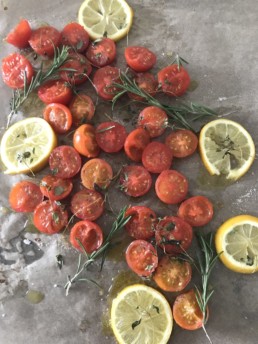What's for Supper - Easter Sunday with confit salmon & oven dried tomatoes with celeriac mash
After so many warm and sunny weeks in Cambridge, I am glad to be using up the last of my winter root vegetables, which were stored in a shady corner of my balcony. With this mash, the last Celeriac of the season goes and I am now mentally and culinarily ready to move on to new potatoes and asparagus!
In French, confit, means a preserve, a jam, and it is the kitchen term for cooking something slowly with an aim to preserve it. The food can be slow cooked in oil, or a sugar and water, at low temperatures over a longer period of time than cooking at normal temperatures would require. The most well known savoury dish is confit duck, where the slow cooked duck legs are left to cool down, and kept completely buried in the cooking fats, thus hermetically sealed in. This method allows for fresh duck to be kept for months on end. When using confit'ing to cook fish or vegetables at low temperature, in a fat, the aim is not so much to preserve, more to gain the benefits which are unrivalled succulence and none of the usual dimming of colour associated with other cooking methods. The green of vegetables is just as vibrant after being confit'ed as is the bright red of wild salmon.
The results are similar to those acquired by sous vide cooking (sous vide meaning "under vacuum"), where food is vacuum packed into plastic bags before being immersed in a water bath and kept at a constant low temperature for many hours, often over night, so it's ready to quickly brown and serve for service. It cuts down on waste, as there is no shrinkage during cooking, it makes the work of chefs infinitely easier as there is no need to check the food while cooking to gauge if the interior temperature and consistency is exactly as required when there is only the exterior to go by; and it also guarantees the same result over and over. So a method introduced to make life in big kitchens easier, became all the rage as it results in tender, succulent and vibrant looking food, cooked in its own juices.
Slow cooking at low temperature, in oil, results in meltingly delicious and soft protein, plant and animal based. I tend to give my confit salmon a Swedish touch by gently rubbing in sea salt and sugar and leaving it like that for about 30 minutes before I cook it. Today I added some rosemary as well, before immersing it in olive oil and cooking it at 70C - one of the very lowest settings for my oven. The time depends on the size of the pieces of salmon, but for small pieces like mine, about half an hour sufficed. The fish should be cooked - just - but won't be firm as it is when oven roasted or pan fried, but tender and soft.
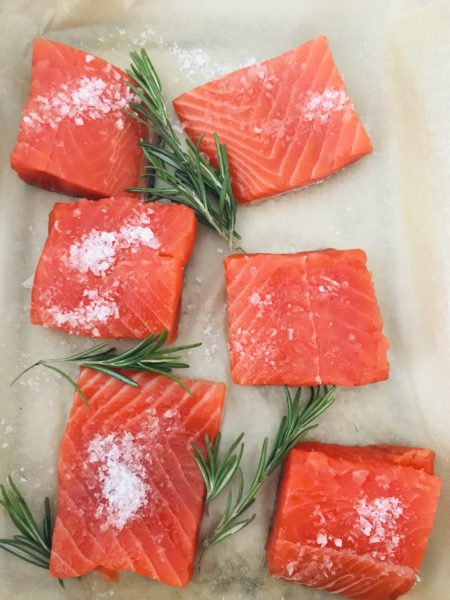
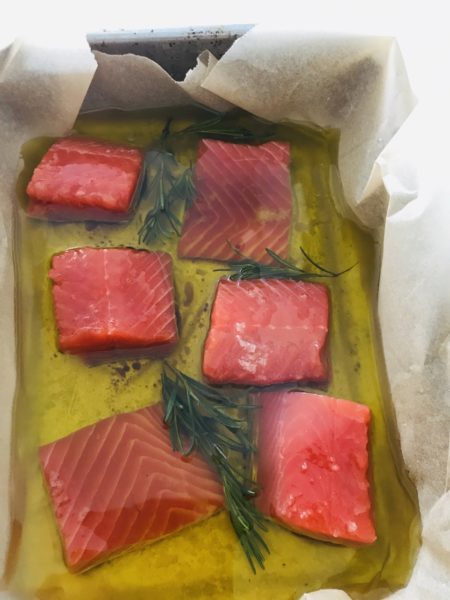
While so many shelves were empty in the shops after those frantic days before lock down, one shelf remained miraculously resplendent; the tomato shelf. Either we have a serious over supply of tomatoes or tomatoes were rejected in the rush to buy long life ingredients. I decided to use another slow cooking method for my ample supply of cherry tomatoes - oven drying until demi-sec, not totally dried. I added some sliced lemon and some more of my fresh rosemary, sprinkled on sea salt and tiny bit of sugar, poured a little oil over and left them in an oven for 90 minutes, at a temperature of 120C.

With both the salmon and the tomatoes taking care of themselves in the oven, I turned my attention to making celeriac mash. Cut away the skin, cut into cubes, simmer in salted water until soft, mash. Beat in butter and a little full fat milk. I always add a little cream, if I have it, to any mash I make. I often throw in one large, cubed, King Edward potato with a celeriac or parsnip mash as it gives a smoother texture when mashed. For one celeriac I used almost 100g butter and about 100ml milk/cream. Rich, yes, but serving 8 (with my portion control, anyway) that is not bad. And it is a treat. If you are keen to restrict fat, the you could roast the celeriac, whole, wrapped in foil, for a couple if hours, or slice it and cook with with already softened sliced onion, in a stock, to make a delicious Boulangère or bake it with a few knobs of butter, some herbs and a few good splashes of that favourite stove side tipple of mine, Marsala wine!

What's for supper tomorrow
Delicious plant based, Indian inspired favourites from another outstanding chef on our team, Jackie Hobbs. A bank holiday feast of Red lentil Dahl, roasted sweet potato with fennel and cumin, Coconut relish and yoghourt raita with mint and cucumber. Join us at the table!
What's for Supper Breakfast special - 5 second scramble
In preparation for my Monday morning zoom yoga class with local teacher and café regular Helen Pomeroy, I felt some protein was in order. What better than a 5 second scramble. A healthy, lean protein breakfast, brunch or lunch which takes a total of three minutes to make if you include toasting bread, getting your utensils out, cooking and plating up! Not many dishes deliver that.
We often get asked by our guests in the café how we make our popular scramble. Fast and furious are the key words. We use eggs, a teaspoon of sunflower oil and full heat under the pan. No cream, no water and most definitely no milk.
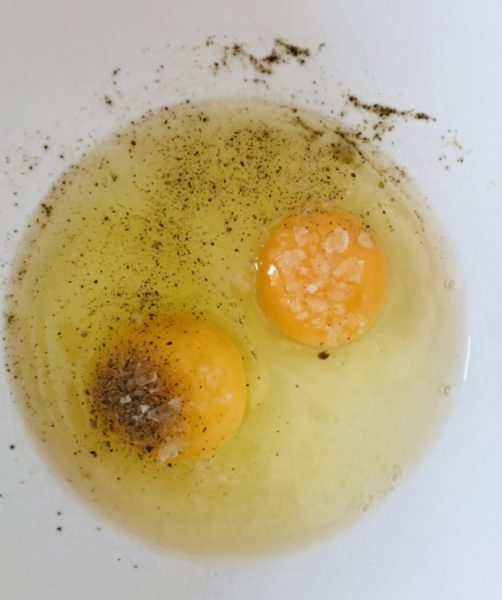
Break up the eggs using a fork. Don't whisk, just mix to create an elastic texture.
While you do this, whack the heat up under you frying pan in which you have poured about half a teaspoon of sunflower oil. Tip in the eggs, spatula or fork at the ready - as shown in the little video clip here. Some of may shudder at the sound of my stainless steel fork in my non stick pan. There is something about plastic, silicon and rubber utensils that I find unappetising and quite annoying, so I prefer a fork, applied with a light touch. So far, my trusted pans remain unscathed.
SCRAMBLE clip
Tip the scramble onto a piece of toasted sour dough. I love adding Sriracha sauce - creamy egg and hot chilli is a match made in heaven. I am also unapologetic about my love of parsley.
What's for supper this evening
My recipe for supper this evening will be my take on Borscht - a savoury, umami-redolent, muscular Beast from the East soup. All you will need is potato, beets (raw) onion, garlic, stock...
What's for Supper - Laxpudding or Swedish potato and smoked salmon gratin
Laxpudding is one of the most quintessentially Swedish dishes alongside Jansson's Temptation and Meat balls with lingonberry jam. It is a cheap everyday dish, despite the use of smoked salmon, of which one does not require very much. The main ingredient is the backbone of Swedish cuisine - potato, combining it here with a savoury custard of milk and egg, and of course dill, the herb which infuses so much of Swedish food and drink. Originally, Laxpudding, which hales from the far north where my mother grew up, was traditionally made using home cured Gravad Lax. Salmon was so commonplace on the Swedish table in the early 1900s that people were bored with it and begged not to be served it every day. The Bothnian Bay and the many rivers in the north were teeming with wild salmon so it was a cheap and common place protein.
Laxpudding has become one of the most popular dishes on our lunch menu in the café and I also think that it makes a perfect, light Friday Night supper served with a salad on the side.
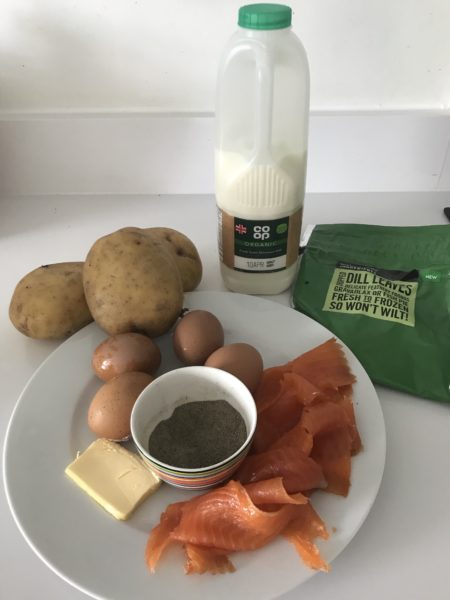

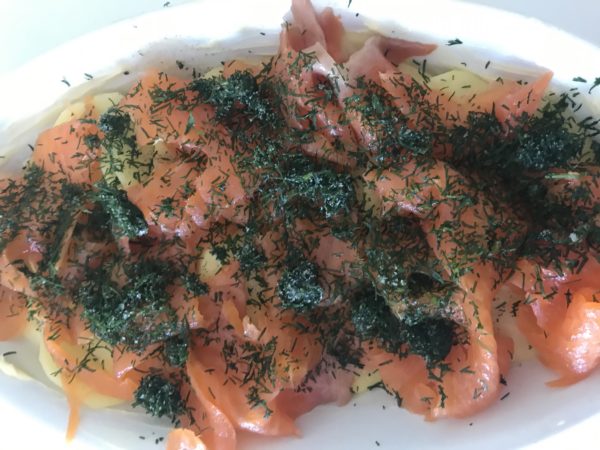
For 2
2 small or 1 large King Edward or similar potatoes, peeled and sliced
150g smoked salmon, torn into smaller pieces
1 tablespoon of finely chopped dill (I have fallen in love with the frozen herb bags from Waitrose)
3 eggs
300ml milk or combo of milk/cream if you have cream sitting around
Sea salt and black pepper
Set the oven to 180C.
Peel and slice the potatoes.
Using a fork, mix the eggs with the milk/cream
Butter an oven proof dish.
Arrange a layer of potato in the base followed by the salmon and dill.
Season with ground black pepper and some sea salt - not too much as the salmon is salty.
Top with a second layer of potato.
Pour over the eggy mix.
I like to dot a few small pieces of butter on top before placing in the oven.
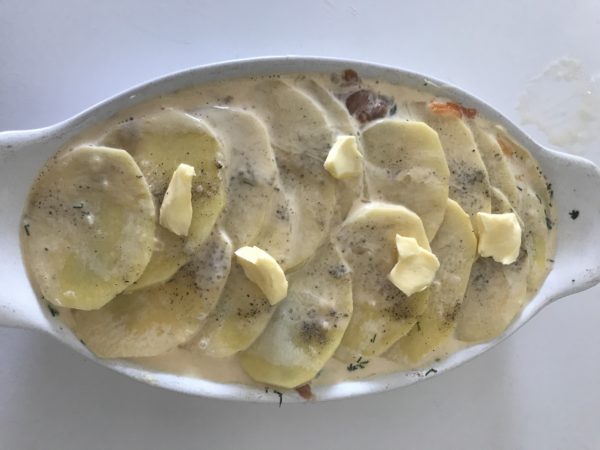
Bake for approx 45 minutes.
In Sweden, Laxpudding is served with melted butter and rye crisp bread on the side.
When enjoyed as a mid-week lunch or supper the drink of choice would be water or low alcohol beer. My wine recommendation for this salty, umami-redolent and creamy dish would be an equally rich white, say a Chardonnay or a Côte du Rhône Blanc.
Laxpudding is a must on any table for Easter, Midsummer or Christmas, the three big food events in Sweden, and for which more or less the same dishes are served. We stick to what we like! The classic drinks accompaniment for the festivities are lager and snaps - the much loved Swedish aquavit. Often flavoured with dill and cumin, and served ice cold in small shot glasses, it is the perfect accompaniment for Sweden's many salty, cured and pickled dishes.
We tend to get emotional when we eat and drink these iconic dishes, which means we want to sing. The songs accompanying snaps are plentiful and usually rather ribald. The themes are, to put it mildly, somewhat repetitive; the appreciation of snaps, the life enhancing qualities of snaps and a call to focus on where the next snaps is going to come from. The play on words, full of double entendre, is often rather clever - even if it relates mainly to the celebration of inebriaty, its effect on various bodily functions - not all negative - in a fashion that most 5 year olds would love. That's us Swedes - a basic lot. Skål!
Join me again for a weekend of home bread making
Judging by the disappearance of flour and yeast from the shelves even before the lockdown was announced, I assume that most of you have both these things in your pantry and that you might like a bit of advice on how to make fantastic bread without much effort! I am going to post the first of several blogs on Sour Dough today, so those who wish can create their first starter today. For tomorrow morning, a super simple recipe for little breakfast milk rolls.
